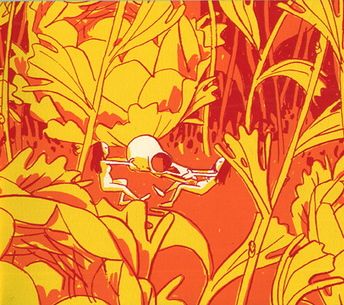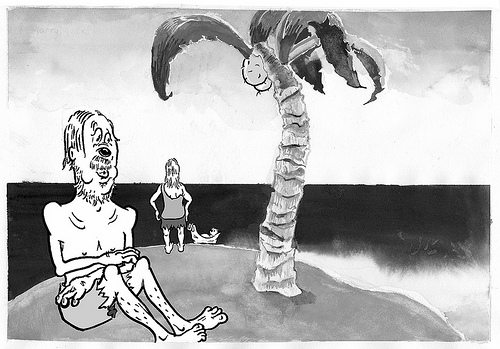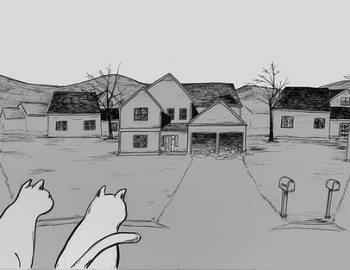The editors of the Sundays anthology are all graduates of the Center for Cartoon Studies. The first, oversized edition made a splash when it debuted at the MOCCA Art Festival in 2007. A few years before the similarly oversized Kramer's Ergot #7 was published, the Sundays editors were inspired by the huge Little Nemo collection and invited their classmates to work at Sunday comics page size. The second issue was more of the same, at a slightly smaller size. The third issue's editorial staff was pared down to the group of Sean Ford, Chuck Forsman, Alex Kim, & Joseph Lambert. That third volume was a significant step up in both quality and variety, as the editors started to seek out talent from outside their CCS peer group. It came in the form of three separate minicomics bound together by a ribbon, and it celebrated the minicomic as art object.
 Cover to Sundays Volume 4 by Damien Jay
Cover to Sundays Volume 4 by Damien Jay
The fourth and most recent volume is credited to that same editorial quartet, though Forsman notes on the anthology's website that he wound up performing most of the editorial duties himself. Forsman's work has always shown an idiosyncratic charm and the same is certainly true of his editorial judgment. The end result is an anthology featuring creators just a couple of steps away from becoming much more well known. If I was a reader looking for the cutting edge of cartooning, Sundays 4 would be a great place to start. This issue, roughly organized around the vague theme of "forever changes," has a wide variety of narrative styles and strategies and has very few missteps.
The first strip is by Mickey Zacchilli (aka Mickey Z), and it's a dense, immersive strip about a type of spore that infects ants. Zacchilli's text is scrawled right on top of the detailed drawings that are washed with screentone. Like most of the strips in this book, it's a short story that makes a quick impact with some off-kilter humor. Jeff Lok's "Blessing" combines the simplicity of of his normal line with a gray wash that grounds the outrageously grim nature of this gag about a couple marooned on a stereotypical desert island with a single coconut tree and a baby that arrives via stork. Ed Piskor's one-page autobio piece about aging is typically acerbic and funny.

Aaron Cockle's "What We Knew And When We Knew It" is a fitting story to follow Craghead's, given his elliptical storytelling style and simple line. It's a story done in the style of a spy report about the activities of a young woman that may as well be her own journal. It details her creative & work habits and her slowly destroying all evidence of same, ending with both loneliness and the possibility of a new project. Melissa Mendes is next with an equally quirky and evocative story about a trip to the store to collect "everything green" that becomes a trip to African grasslands.
Joseph Lambert contributes a story about a young boy grown to such a large size that he's stuck in his house. Lambert has recently started to add a greater tone of sadness to his stories apart from the depiction of the ways in which children act. This story combines melancholy, wonde,r and whimsy in equal measures, all told with Lambert's impeccably beautiful line. In particular, Lambert nails the experience of boredom and loneliness and how children experience them in the way the young boy starts naming different kinds of clouds that drift by. 
Alex Kim's story is another highlight of this volume, depicting an artist working tirelessly on a huge mural at the expense of his own health. When one of his figures (a catfish) tells him he's satisfied, the artist finally expires. Kim then unrolls the mural one page at a time, detailing an absurd, epic battle between catfish and other fish. His usual spare, vibratory line transforms, and a startling, bold series of figures unexpectedly appears. In a segue that acts as a marker for the halfway point of the book, David Libens's sketchy autobio about the ways in which his young sons are growing interprets the theme from a different angle. His story is sentimental without being overly cloying, even if he hammers home his theme unnecessarily. Libens spells out why their growing bothers him and how he deals with it in a narrative caption, where a more ambiguous approach might have been more effective.
Forsman is careful to vary visual approaches from strip to strip. The dense, detailed and black-oriented pencils of Ariyana Swarnasuddhi are dramatically different from the cartoony scrawl of Dane Martin. Martin's dot-heavy anthropomorphic characters have a dirty but lively appeal, and this story goes to some strange places as it depicts a dying dog going to heaven, trying to sort out his place in the world. Martin is not a widely published cartoonist, but he's certainly one of the weirder and more interesting cartoonists to emerge from the Center for Cartoon Studies.
Another contrast in styles of abutting strips is that of Julia Delporte and Michael DeForge. Delporte's strip consists of a series of pencil drawings with accompanying text that elliptically depicts a breakup. DeForge employs a simple line but relies on heavy inks and blacks to tell what seems to be a grotesque & absurd story with S&M elements that winds up being a darkly humorous take on fraternity life and the lengths one goes to live in the past. DeForge's punchy style lends itself to short stories like this one, and he manages to fall right into the anthology's theme in doing so.
Following what turns out to be a story with a punchline is Sean Ford's contribution, a typically apocalyptic vision of two cats watching a man on fire run out of a house, with one cat declaring, "It's the end of a certain age, isn't it Morris?" It's funny because of our own inability to fully comprehend the world's events and what they truly mean on a larger scale. Sam Gaskin contributes a fairly straight-ahead story about a samurai having an affair with another man's wife, and the ways in which his actions doom everyone involved. It's not a funny story, nor does it particularly fit in with the rest of the anthology. I'm not entirely sure what Gaskin was going for here, because it doesn't work all that well as drama or action either. The subsequent story by Scott Longo dips too far into mark-making territory to latch onto as a reader, especially given just four pages.
The anthology ends with a strong run of stories. Jose-Luis Olivares' scribbles serve this story about a cave boy finding a dinosaur egg well, especially when he fast-forwards to the present in the strip's punchline. Like Lambert and Mendes, Olivares has an intuitive understanding of the way children think and act. Mari Ahokoivu is one of several international artists to contribute (she's from Finland, Libens & Max de Radigues are Belgians, and Delporte is Canadian). Her loopy-lined, light-hearted contribution (featuring a long-legged giant outpacing a tiny figure) fit in with the many minimalist contributions in the book. De Radigues's piece is his usual focus on the teenage experience (he's a sort of Belgian Dave Kiersh in that regard), zeroing in an a break-up that devastates a boy in a melodramatic, over-the-top manner. His attempt to gain a measure of revenge and satisfaction doesn't work long, as he can lie to his ex-girlfriend, but he can't lie to himself. As always, it's the details that make the difference in one of his clear-line comics; here, it's the way in which the boy takes aim at his own possessions, his body shaking with rage and grief, that drive home the ways in which teens have trouble processing emotions.
Damien Jay and Lydia Conklin round out the anthology. Jay works in the same sketchy line and wash that he uses in his The Natural World series, which allows the reader to see the lines as lines as well as compositional devices. It's a supernatural tale that fits into the anthology's theme by making a explorer's discovery his final one—on a surprisingly voluntary basis. Conklin tells one of her typical dog stories, this time of a dog committing suicide by walking across a desert. It's a weird final image, one that makes sense in the somewhat fatalistic context of the anthology.
Sundays 4 provides a taste of a number of interesting talents. For a number of these artists, it's work that's slight when compared to their other comics. The pieces by Mendes, Ford, Conklin, Burrier, and Gaskin in particular are too short to make a significant impact. On the other hand, Kim, Craghead, DeForge, Cockle, Martin, and Zacchilli contribute stories that stand with the rest of their work in terms of quality. Even the slight misfires have some interesting elements, and there's much for a new reader to appreciate.
As an editor, Forsman does a fine job at sequencing the stories to create a flow that makes sense. Considering how challenging so many of the styles are in the anthology, it's a remarkably smooth read. Working with mostly unknown or emerging cartoonists (along with more experienced cartoonists like Craghead), the Sundays editors have reproduced the Kramer's Ergot model in terms of springing new and interesting work on the comics world in a single volume. At this point, more ambition will be needed. I'd like to see the judicious addition of color to the anthology (pieces by Mendes, Olivares, Longo, and others fairly demanded it), as well as more longer pieces. Sundays is a very good anthology that has the potential to make an even bigger splash in the future, given time and resources.














